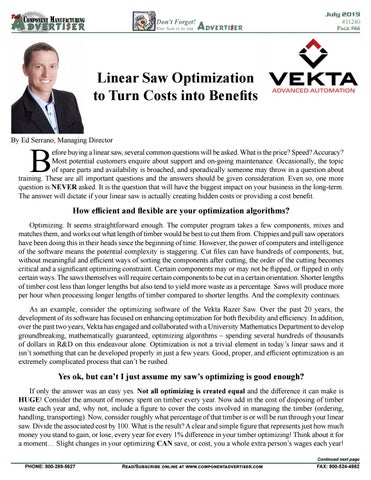A
Th e
Component Manufacturing dverti$er
Don’t Forget! You Saw it in the
Adverti$er
July 2019 #11240 Page #66
Linear Saw Optimization to Turn Costs into Benefits By Ed Serrano, Managing Director
B
efore buying a linear saw, several common questions will be asked. What is the price? Speed? Accuracy? Most potential customers enquire about support and on-going maintenance. Occasionally, the topic of spare parts and availability is broached, and sporadically someone may throw in a question about training. These are all important questions and the answers should be given consideration. Even so, one more question is NEVER asked. It is the question that will have the biggest impact on your business in the long-term. The answer will dictate if your linear saw is actually creating hidden costs or providing a cost benefit.
How efficient and flexible are your optimization algorithms? Optimizing. It seems straightforward enough. The computer program takes a few components, mixes and matches them, and works out what length of timber would be best to cut them from. Chippies and pull saw operators have been doing this in their heads since the beginning of time. However, the power of computers and intelligence of the software means the potential complexity is staggering. Cut files can have hundreds of components, but, without meaningful and efficient ways of sorting the components after cutting, the order of the cutting becomes critical and a significant optimizing constraint. Certain components may or may not be flipped, or flipped in only certain ways. The saws themselves will require certain components to be cut in a certain orientation. Shorter lengths of timber cost less than longer lengths but also tend to yield more waste as a percentage. Saws will produce more per hour when processing longer lengths of timber compared to shorter lengths. And the complexity continues. As an example, consider the optimizing software of the Vekta Razer Saw. Over the past 20 years, the development of its software has focused on enhancing optimization for both flexibility and efficiency. In addition, over the past two years, Vekta has engaged and collaborated with a University Mathematics Department to develop groundbreaking, mathematically guaranteed, optimizing algorithms – spending several hundreds of thousands of dollars in R&D on this endeavour alone. Optimization is not a trivial element in today’s linear saws and it isn’t something that can be developed properly in just a few years. Good, proper, and efficient optimization is an extremely complicated process that can’t be rushed.
Yes ok, but can’t I just assume my saw’s optimizing is good enough? If only the answer was an easy yes. Not all optimizing is created equal and the difference it can make is HUGE! Consider the amount of money spent on timber every year. Now add in the cost of disposing of timber waste each year and, why not, include a figure to cover the costs involved in managing the timber (ordering, handling, transporting). Now, consider roughly what percentage of that timber is or will be run through your linear saw. Divide the associated cost by 100. What is the result? A clear and simple figure that represents just how much money you stand to gain, or lose, every year for every 1% difference in your timber optimizing! Think about it for a moment… Slight changes in your optimizing CAN save, or cost, you a whole extra person’s wages each year! Continued next page
PHONE: 800-289-5627
Read/Subscribe online at www.componentadvertiser.com
FAX: 800-524-4982
